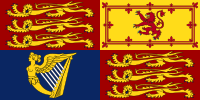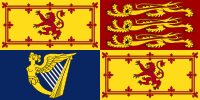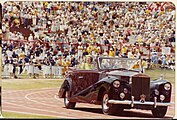Flags of Elizabeth II

| ||
|---|---|---|
|
Reign Personal  |
||
Elizabeth II had a variety of flags to represent her personally and as head of state of several independent nations around the world. They were usually used on any building, ship, car, or aircraft where she was present.
These heraldic flags were usually a nation's coat of arms in banner form.
As Princess Elizabeth
Princess Elizabeth's personal standard prior to her accession as Queen was her coat of arms in banner form. This consisted of four quarters consisting of three lions passant for England, a lion rampant for Scotland, and a Gaelic harp for Ireland. To differentiate the arms of Princess Elizabeth from that of the King it was differenced with a white label of three points, the centre point bearing a Tudor rose and the first and third a cross of St George.[1][2] The flag was adopted in 1944 and was used for the first time on 30 November 1944, at the launch of HMS Vanguard (23) by the Princess.[3]
- 1944–1952
- Scottish version
As sovereign
Immediately upon becoming Queen, Elizabeth inherited the two versions of the royal standard of the United Kingdom. Since the 1960s, flags were introduced to represent the Queen in various other Commonwealth realms, which followed the same basic pattern: the nation's coat of arms in banner form with the device found on her personal flag.[4] The Queen's representatives in these nations had their own flags to represent them.[5]
United Kingdom
Upon the death of her father, Princess Elizabeth became Queen Elizabeth II and therefore adopted the Royal Standard. This flag was used to represent the Queen not only in the United Kingdom but also overseas when she made state visits. It is the royal arms in banner form undifferentiated.
- Outside Scotland
- Scotland
Sierra Leone

The Queen's Sierra Leonean standard was created when she visited Sierra Leone in 1961, in her capacity as Queen of Sierra Leone.[6][7][8] The flag featured the coat of arms of Sierra Leone in banner form, which depicts a lion beneath a zigzag border, representing the Lion Mountains, after which the country was named. It also had three torches which symbolized peace and dignity. At the base were wavy bars depicting the sea. A blue disc of the crowned letter "E", surrounded by a garland of gold roses defaced the flag, which is taken from the Queen's Personal Flag.[9][10] The Sierra Leonean standard also served as the inspiration for the design and layout of her personal standard for Canada.[11]
This flag ceased to be used when Sierra Leone became a republic in 1971.
Canada

The Queen had a personal Canadian Flag in her role as Queen of Canada. The flag was adopted and proclaimed by her on 15 August 1962.[12][13] The flag, in a 1:2 proportion, consists of the escutcheon of the Royal Coat of Arms of Canada in banner form defaced with the distinct device of Queen Elizabeth II:[14] a blue roundel with the initial E surmounted by St Edward's Crown and within a wreath of roses, all gold-coloured.[13]
The standard is protected under the Trade-marks Act; section 9(a) states: "No person shall adopt in connection with a business, as a trade-mark or otherwise, any mark consisting of, or so nearly resembling as to be likely to be mistaken for... the Royal Arms, Crest or Standard".[15]
The Queen's Canadian Standard was also flown sometimes in her absence.[16] To mark the Queen's sixty years on the Canadian throne on 6 February 2012, her personal Canadian standard was unfurled at Rideau Hall and on Parliament Hill, as well as at provincial royal residences and legislatures across the country.[17][18][19][20][21]
Australia

The Queen had a personal Australian Flag in her role as Queen of Australia. The flag was approved for use in by the Queen on 20 September 1962, and first used during the 1963 royal visit.[22] The flag consists of a banner of the coat of arms of Australia, defaced with a gold seven-pointed federation star with a blue disc containing the letter E below a crown, surrounded by a garland of golden roses.[23] Each of the six sections of the flag represents the heraldic badge of the Australian states, and the whole is surrounded by an ermine border representing the federation of the states.[24]
The flag is flown on Royal Australian Navy ships, or on Australian official buildings or in enclosures only on occasions when the monarch is present. The exception to this rule is parades in honour of their birthday, when the flag is flown even if the monarch is not present. When it is flown on or outside a building, no other flag is flown with it.[22]
On 7 July 2000, to celebrate the 100th anniversary of the passage of the Commonwealth of Australia Constitution Act 1900 by the British Parliament, the Queen attended a church service at Westminster Abbey in London. The Queen's personal flag for Australia flew at the Abbey, the first time it had flown in the United Kingdom.[25]
New Zealand

The Queen had a personal flag in her role as Queen of New Zealand. It was approved for use in 1962. It was flown by the Queen when in New Zealand. The only time the flag was flown in New Zealand in the absence of the Queen, was at parades held on and in honour of her official birthday.[26] The flag is the escutcheon of the arms of New Zealand in banner form, defaced with a blue roundel surrounded by a garland of roses encircling a crowned letter 'E', all in gold.[27]
The flag is divided into four quadrants: The first quadrant includes depicts four stars as representative of the Southern Cross constellation, as depicted on the national flag. The second quadrant consists of a golden fleece on a red field. The third quadrant contains a golden wheat sheaf on a red field. The final quadrant includes two crossed gold hammers on a blue field. The central stripe consists of three ships. Superimposed in the centre is a dark blue roundel bearing a Roman E surmounted by a Royal Crown within a chaplet of roses, all gold-coloured, obscuring the centre ship.[27][28]
The flag takes precedence over the New Zealand flag,[29] and is protected under the Flags, Emblems, and Names Protection Act 1981; Section 12(1) states: "Every person commits an offence against this Act who, without the authority of Her Majesty or (as the case may require) the Governor-General, displays or exhibits or otherwise uses any representation to which this subsection applies in such a manner as to be likely to cause any person to believe that he does so under the authority, sanction, approval, appointment, or patronage of Her Majesty or the Governor-General".[30]
An example of the Queen's New Zealand Standard being used outside New Zealand, is at the unveiling of the New Zealand War Memorial in London, UK, by the Queen at Hyde Park in 2006. The Queen's Personal New Zealand Standard was flown, along with the Union Flag, and the flag of New Zealand on three separate freestanding flagpoles at the ceremony.[31]
Trinidad and Tobago
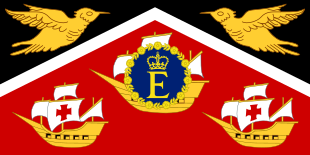
The Queen's personal flag for Trinidad and Tobago was used for the first time when she visited Trinidad and Tobago in 1966. The flag featured the coat of arms of Trinidad and Tobago in banner form, which depicts the colours of the national flag. The gold ships represent the three ships Christopher Columbus used on his voyage. The two birds above are hummingbirds.[32] A blue disc of the crowned letter "E", surrounded by a garland of gold roses defaced the flag (obscuring the centre ship), which is taken from the Queen's Personal Flag.[7][33][34][35]
This flag ceased to be used when Trinidad and Tobago became a republic in 1976.
Jamaica

The Queen had a personal flag in her role as Queen of Jamaica. It was first used when she visited Jamaica in 1966, as part of her Caribbean tour.[35] The flag consists of a banner of the coat of arms of Jamaica defaced with the Queen's Royal Cypher. The flag is white and bears a red St George's Cross. A gold pineapple is superimposed on each arm of the Cross. A blue disc with the Queen's initial is placed in the centre of the Cross (obscuring the central pineapple). The disc is taken from the Queen's Personal Flag.[36][33][37]
Malta

The Queen had a personal flag for use in Malta, in her role as Queen of Malta.[38] The flag was adopted on 31 October 1967, and first used when the Queen visited Malta in 1967. The flag consisted of the Coat of arms of Malta in banner form, which depicts the colours white and red, and a representation of the George Cross, awarded to Malta by George VI in 1942. A blue disc of the crowned letter "E", surrounded by a garland of gold roses defaced the flag, which is taken from the Queen's Personal Flag.[7][34][39]
This flag ceased to be used when Malta became a republic in 1974.[39]
Mauritius
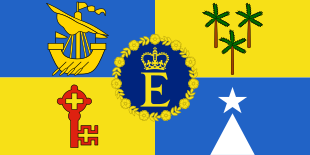
The Queen's personal flag for Mauritius was first used when she visited Mauritius in March 1972. The flag consisted of the coat of arms of Mauritius in banner form: quarterly azure and or, in the first quarter a lymphad of the last in the second, 3 palm trees eradicated vert, in the third, a key in pale the wards downwards gules, and in the issuant, from the base a pile, and in chief a mullet argent.[40] A blue disc of the crowned letter "E", surrounded by a garland of gold roses defaced the flag, which is taken from the Queen's Personal Flag.[34]
This flag ceased to be used when Mauritius became a republic in 1992.
Barbados
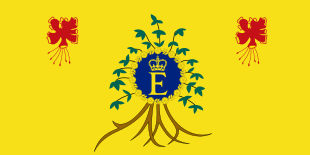
The Queen had a personal flag for use in Barbados, in her role as Queen of Barbados. It was first used when the Queen visited Barbados in 1975.[41][42] The standard consisted of a yellow field with a bearded fig tree, a long-established symbol of the island of Barbados, and the national flower the Pride of Barbados flowers in each of the upper corners. A blue disc of the crowned letter "E", surrounded by a garland of gold roses, was displayed prominently on the flag within the centre of the tree.[34][43]
This flag ceased to be used when Barbados became a republic in 2021.
Personal flag


The Queen's personal flag was displayed on any building, ship, car, or aircraft in which she would have stayed or travelled.[44][45] It often represented the Queen in her role as Head of the Commonwealth or as monarch of a Commonwealth realm in which she did not possess a unique flag.[44]
This flag, designed by the College of Arms in 1960, bears the crowned letter E in gold, surrounded by a garland of gold roses on a blue background, with a golden fringe.[46][47] The crown is a symbol of the Queen's rank and dignity, whilst the chaplet roses symbolise all the countries of the Commonwealth.[48][49][4]
The flag was created at the Queen's request in December 1960 to symbolise her as an individual, not associated with her role as sovereign of any particular Commonwealth realm.[49][45] It was designed as an alternative to the Royal Standard,[50] for use chiefly in Commonwealth republics where the British heraldic devices have no historic significance,[51] and to Commonwealth meetings where the Royal Standard would be considered inappropriate.[52][53]
It was first used in 1961 for the Queen's visit to India.[47] It was flown for the first time in the BOAC Britannia in which the Queen landed at Delhi Airport.[45]
Over time, the flag started to be used in place of the British royal standard when the Queen visited Commonwealth countries where she was not head of state, Commonwealth realms where she had no specific standard, and for Commonwealth occasions in the United Kingdom; it came to symbolise the Queen as Head of the Commonwealth.[53] Eventually, the practice evolved wherein the flag was raised at Marlborough House (the headquarters of the Commonwealth Secretariat) in London when the Queen visited, rather than the Royal Standard of the United Kingdom.[49]
Others
As Lord High Admiral

In 1964, the Queen assumed the office of the Lord High Admiral of the United Kingdom. In this capacity, the Queen flew a special Lord High Admiral's flag. It was flown when the Queen was at sea, and at naval establishments ashore on official occasions, when it flew alongside the Royal Standard.[54][55]
Gallery
- Princess Elizabeth's standard flying in the background, during her 1951 royal tour of Canada
- The Royal Yacht Britannia flying the Royal Standard and the Flag of the Lord High Admiral, 1977
- The Queen's Canadian Standard flying on her car, at the opening of the 1978 Commonwealth Games in Edmonton, Alberta
- The Queen's Australian Standard being used by her at Brisbane, 1982
- The Royal Standard flying above the Round Tower at Windsor Castle, 2006
- The Scottish Royal Standard flying over Holyrood Palace, 2007
- The Queen's Canadian standard flying from the Peace Tower on Parliament Hill, 1 July 2010
- The British Royal Standard flying on top of the Queen's car during the wedding of Prince William and Catherine Middleton
- The Royal Standard flying on top of the Queen's car, during her state visit to Germany, 2015
- The Queen's personal flag flying at the Commonwealth Day parade in Belize City, 2019 (Although she was Queen of Belize, she had no Belizean Standard)
See also
References
- ^ The Nautical Magazine: Volumes 167–168, Brown, Son and Ferguson, 1952, p. 113
- ^ Gordon Campbell, Idrisyn Oliver Evans (1953), The Book of Flags, Oxford University Press, p. 12
- ^ Ray Burt (2019), The Last British Battleship: HMS Vanguard, 1946–1960, Pen & Sword Books, ISBN 9781526752277
- ^ a b Charles Boutell, John Philip Brooke-Little (1970), Boutell's Heraldry, F. Warne, p. 256, ISBN 9780723211204
- ^ Flags of the World, F. Warne, 1978, p. 48, ISBN 9780723220152
- ^ "Queen causes a frenzy in Freetown: A royal visit to Sierra Leone creates colourful boating chaos". The Observer. 26 November 1961. Retrieved 8 November 2015.
- ^ a b c Flags of the World, F. Warne, 1978, p. 27, ISBN 9780723220152,
The Royal Standard had accordingly been designed for Sierra Leone, Canada, Australia, New Zealand, Jamaica, Trinidad and Tobago, and Malta.
- ^ Cathcart, Helen (1962), Her Majesty the Queen: The Story of Elizabeth II., Dodd, Mead, p. 236,
When she adopted a new personal flag specifically for use in Sierra Leone "to fly on all occasions when Her Majesty is present in person", the monarch endowed special ceremonial status upon one of her smaller independent states.
- ^ Sierra Leone Trade Journal, Ministry of Information and Broadcasting, 1961, p. 52,
The new personal flag which the Queen has adopted for use in Sierra Leone during her visit in November. It consists of a flag of THE ARMS OF SIERRA LEONE charged in the centre with Her Majesty's own device, namely on a blue field the initial letter 'E' ... Royal Crown both in gold (or yellow) all within a ... of roses also in gold (or yellow).
- ^ "SIERRA LEONE FLAGS. H.M the Queen for Use in Sierra Leone, vintage print 1958". Alamy. 1958. Retrieved 14 May 2021.
- ^ Bousfield, Arthur; Toffoli, Garry (2002). Fifty Years the Queen: A Tribute to Her Majesty Queen Elizabeth II on Her Golden Jubilee. Dundurn. p. 119. ISBN 9781459714359.
The inspiration for the flag came from the personal one that had been adopted at the Queen's own instigation for Sierra Leone the previous year. The Queen's flag was to be used in whatever place in the country the Sovereign personally present.
- ^ John Ross Matheson (1980), Canada's Flag: A Search for a Country, G. K. Hall, p. 22, ISBN 9780816184262
- ^ a b Office of the Governor General of Canada: Canadian Heraldic Authority. "Public Register of Arms, Flags, and Badges > Registration of the Flag of Her Majesty the Queen for personal use in Canada". Queen's Printer for Canada. Retrieved 22 November 2012.
- ^ Department of Canadian Heritage (13 December 2013). "Ceremonial and Canadian Symbols Promotion > The crown in Canada > The Queen's Personal Canadian Flag". Queen's Printer for Canada. Archived from the original on 8 June 2011. Retrieved 24 September 2009.
- ^ Elizabeth II (2008), Trade-marks Act, 9.1.a, Ottawa: Queen's Printer for Canada (published 1985), R.S., 1985, c. T-13, retrieved 28 October 2009
- ^ "The Queen's Personal Canadian Flag". Government of Nova Scotia. Retrieved 23 December 2021.
- ^ Office of the Lieutenant Governor of Nova Scotia (23 January 2012). "Media > News and Events > Diamond Jubilee Events". Queen's Printer for Nova Scotia. Archived from the original on 4 March 2012. Retrieved 16 February 2012.
- ^ "Manitoba Celebrating Queen's Diamond Jubilee". ChrisD. 6 February 2012. Archived from the original on 31 July 2012. Retrieved 6 February 2012.
- ^ Office of the Lieutenant Governor of Prince Edward Island (3 February 2012). "Diamond Jubilee Celebrations Begin". Queen's Printer for Prince Edward Island. Archived from the original on 6 June 2012. Retrieved 29 February 2012.
- ^ Northwest Territories Executive. "Department of Executive > Offices of the Executive > Protocol > NWT Jubilee Events". Government of the Northwest Territories Publications. Archived from the original on 3 July 2013. Retrieved 26 July 2012.
- ^ "Canada kicks off festivities for Queen's jubilee". CTV. 6 February 2012. Archived from the original on 18 March 2012. Retrieved 6 February 2012.
- ^ Debrett's Handbook of Australia and New Zealand, Debrett's Peerage, 1984, p. 207, ISBN 9780949137005
- ^ Government of Australia: Department of the Environment and Water Resources
- ^ "Her Majesty The Queen's personal flag for Australia". Department of the Prime Minister and Cabinet. Retrieved 7 February 2023.
 Text was copied from this source, which is available under a Creative Commons Attribution 4.0 International License.
Text was copied from this source, which is available under a Creative Commons Attribution 4.0 International License.
- ^ "Symbols and ceremonies", Royal.uk
- ^ a b "Other flags", Ministry of Culture & Heritage, retrieved 18 September 2021
- ^ "The Queen's personal flag for NZ". New Zealand. Retrieved 20 December 2021.
- ^ "Other flags". Te Ara - the Encyclopedia of New Zealand. Retrieved 20 December 2021.
- ^ Flags, Emblems, and Names Protection Act 1981, Section 12(1)
- ^ "The Queen, Blair and Clark unveil a memorial to New Zealand war dead". AP Archive. Retrieved 22 December 2021 – via YouTube.
- ^ Gordon Campbell, Idrisyn Oliver Evans (1974), The Book of Flags, Oxford University Press, p. 73, ISBN 9780192731326
- ^ a b Pedersen, Christian Fogd (1971), The International Flag Book in Color, Volume 10, Morrow, p. 211, ISBN 9780688018832
- ^ a b c d Flag Bulletin, Volume 27, Flag Research Center, 1988, p. 134,
PERSONAL FLAGS The Royal Standard is the flag used to represent Queen Elizabeth II throughout the United Kingdom and dependencies , in all non-Commonwealth countries, and sometimes in the dominions. .. Australia, New Zealand, Jamaica, Barbados, Mauritius ... Sierra Leone, Malta, and Trinidad and Tobago also had such flags.
- ^ a b Cathcart, Helen Fogd (1966), Her Majesty the Queen: The Story of Elizabeth II., Dodd, Mead, p. 211,
On her Caribbean tour in the royal yacht Britannia in 1966, as Queen of the newly self-governing territories of Jamaica, Trinidad and Tobago, she had adopted a personal flag "to fly on all occasions when Her Majesty is present in person.
- ^ Symbols and ceremonies Archived 12 May 2015 at the Wayback Machine
- ^ Flags of the World, F. Warne, 1978, p. 102, ISBN 9780723220152
- ^ Flag Bulletin, Volume 12-14, Flag Research Center, 1973,
Queen Elizabeth, who had a special standard for use in her role as Queen of Malta, was replaced by a president as head of state.
- ^ a b Flags of the World, F. Warne, 1978, p. 130, ISBN 9780723220152,
The Queen's Personal Standard for use in Malta was established on 31 October 1967, with the royal cypher on blue in the centre of a banner of the Arms, but this became obsolete when Malta became a republic on 12 December 1974.
- ^ Coat of Arms - Republic of Mauritius
- ^ Flags of the World, F. Warne, 1978, p. 101, ISBN 9780723220152,
The flag of the Queen of Barbados was displayed when Sir Garfield Sobers was knighted by her in February 1975, being a banner of the Arms, with the royal badge in the centre, as in other Commonwealth countries.
- ^ For images, see this, this and this.
- ^ Graham Bartram (2004), British Flags & Emblems, Flag Institute, p. 29, ISBN 9781862322974
- ^ a b "Personal flags". The official website of the British Monarchy. Royal household. Archived from the original on 5 March 2015. Retrieved 4 December 2013.
- ^ a b c The Royal Encyclopedia, Macmillan Press, 1991, p. 188, ISBN 9780333538104
- ^ Compare: Canada and the World. 1960. Retrieved 13 June 2018.
Queen Elizabeth II has adopted a personal flag in addition to the Royal Standard. ... The flag was designed in the College of Arms under the personal direction of the Garter King of Arms, Sir George Bellow. It consists of the letter 'E' ensigned with the royal crown, the whole within a chaplet of roses, all in gold on a blue field.
- ^ a b "British Royal Flags, Reign of Elizabeth II: Personal Flags of Queen Elizabeth II". Flags Of The World.
- ^ Canada in World Affairs: Volume 11, 1965, p. 184
- ^ a b c "Mailbox". Royal Insight. September 2006. p. 3. Archived from the original on 19 November 2008.
- ^ Sir William Dale (1983), The Modern Commonwealth, Butterworths, p. 38, ISBN 9780406174048
- ^ Gordon Campbell, Idrisyn Oliver Evans (1974), The Book of Flags, Oxford University Press, p. 9, ISBN 9780192731326
- ^ The Royal Encyclopedia, Macmillan Press, 1991, p. 109, ISBN 9780333538104
- ^ a b "Personal Flags". The British Monarchy. Archived from the original on 21 October 2004.
- ^ Sir Edward Ashmore (1997), The Battle and the Breeze: The Naval Reminiscences of Admiral of the Fleet Sir Edward Ashmore, p. 216, ISBN 9780750912525,
The Queen alone could now fly the flag of the Lord High Admiral when at sea, a change dating from the unification of the MoD in 1964.
- ^ Brian Hoey (2020), Royalty Revealed: A Majestic Miscellany, Biteback Publishing, ISBN 9781785906244,
She has a special Lord High Admiral's flag that is flown when Her Majesty is at sea, and at naval establishments ashore on official occasions, when it flies alongside the Royal Standard.




